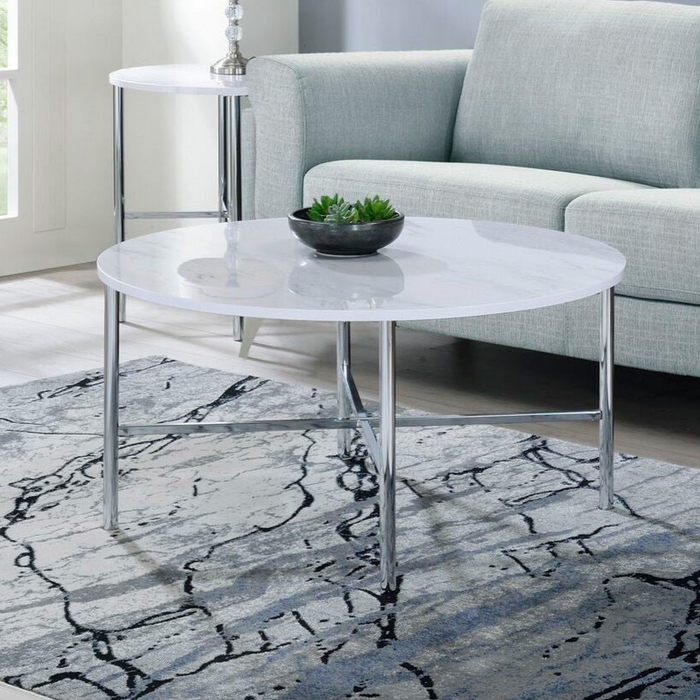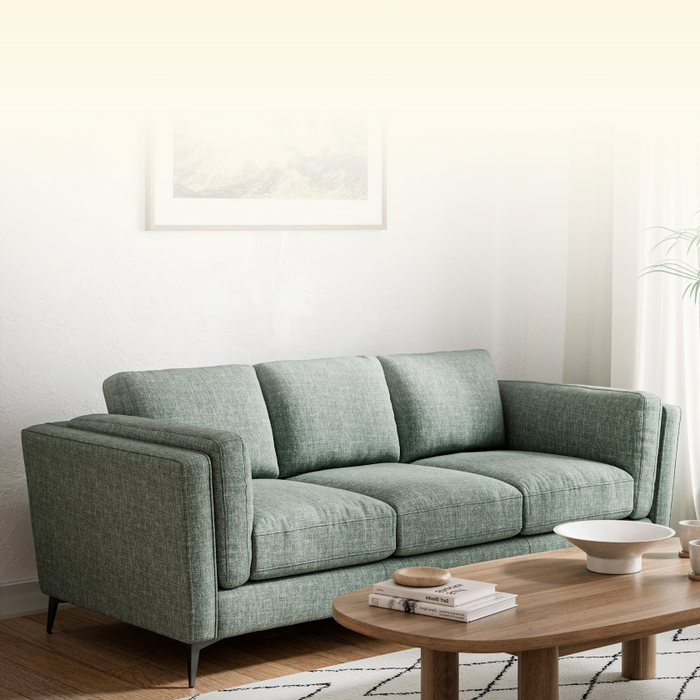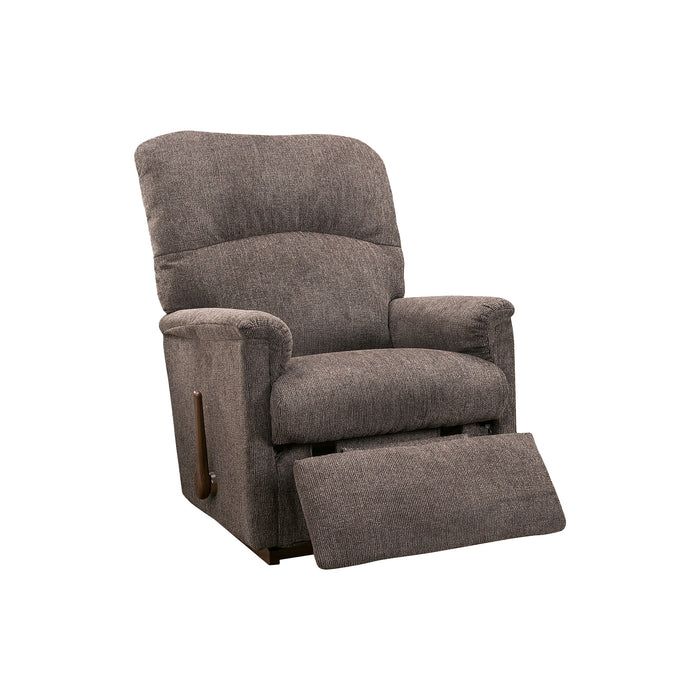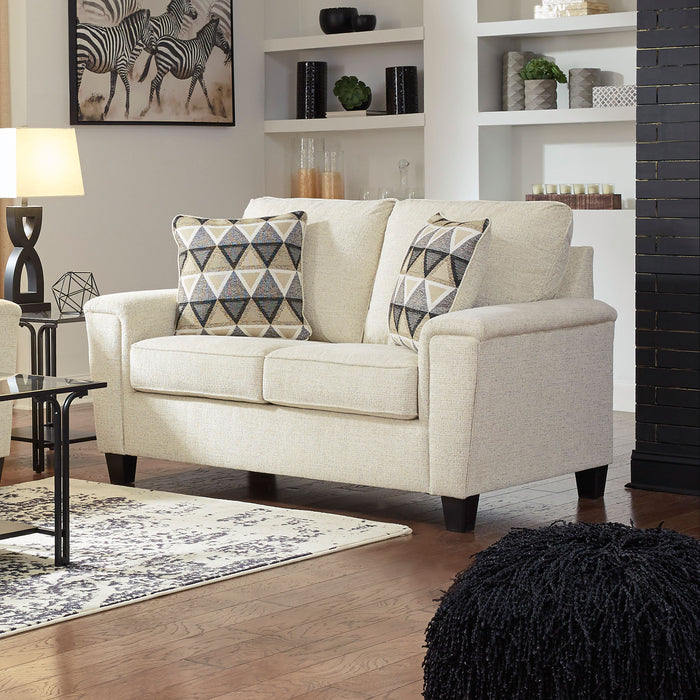An accent chair is more than just an extra seat in your home. Used right, it’s a statement piece that makes your space feel unique and complete.
Unlike a sofa, which sets the foundation of a living space, accent chairs are where personality shines through. They come in endless types, from classic wingback chairs to bold statement pieces, giving you plenty of options to explore. The right chair will be the focal point of your room, balancing your existing furniture and adding a splash of contrast through color, texture, or shape.
In this guide, we’ll answer the most common questions people ask us about accent chairs. We'll also share some décor ideas for different rooms, so you can pick the perfect one.
For quick tips on how to decorate with accent chairs, watch our video:
Table of Contents
What Is an Accent Chair?
An accent chair is a single-seat chair designed to add style to a room while providing extra seating. It is often chosen for its visual appeal as much as its function. It adds decorative appeal to a space by contrasting color, pattern, material, or shape with the rest of your furniture.
Accent chairs come in many designs, like wingback chairs, slipper chairs, and club chairs. They can be upholstered in fabrics, leather, or bold patterns to highlight a room’s personality. They are commonly placed in living rooms, bedrooms, and reading corners.
What Is the Difference Between an Accent Chair and an Armchair?
The main difference between an accent chair and an armchair is purpose. An armchair is designed for comfort and prolonged periods of sitting. They are often bigger and sold as part of a living room set. An accent chair is lighter and chosen as a decoration to add visual interest.
Both can include arms, but not all accent chairs have them. Armchairs are upholstered with comfort in mind, whereas accent chairs focus on style. For example, a plush recliner armchair is built for lounging, while a patterned slipper chair is used to bring character to a space.
Get help finding the perfect recliner here.
How to Pick an Accent Chair
To pick the perfect accent chair for your space, we recommend choosing a shade lighter or darker than the color scheme of your furnishings. You can also opt for a neutral color and add visual interest through a unique chair shape or pattern.
Choosing the right accent chair means balancing style, size, comfort, and placement. When shopping, consider the chair’s dimensions, seat height, and how it compares to your surrounding furniture and decor. Read on to learn how to decide on size, style, color, and material.
Overwhelmed? No worries! Every Slumberland has design experts on staff to help make your furniture shopping a breeze. Find a Slumberland near you!
What Size Accent Chair Do I Need?
An accent chair should be proportional to the size of your room and sofa. In most living rooms, accent chairs range between 30 to 40 inches tall and 25 to 35 inches wide. The seat height of your accent chair should be within four inches of your sofa.
If your sofa is large and deep, opt for a wider or taller chair to create balance. For smaller spaces or bedrooms, a compact accent chair works better without overwhelming the room. As a rule of thumb, your accent chair should not feel oversized compared to your sofa or too small to be practical. It should also allow for a natural traffic flow through the room.
What Is the Best Seat Height for an Accent Chair?
The best seat height for an accent chair is typically 16 to 18 inches from the floor. This matches the standard seat height of most sofas and coffee tables. You should aim for a seat height within four inches of your sofa’s seat height.
Should an Accent Chair Be Taller Than the Sofa?
Accent chairs should generally be equal in height or slightly shorter than the sofa to maintain balance in the room. If the chair is much taller, it can overpower the sofa and disrupt the flow of your seating area.
Learn more about balance and other interior design basics here.
What Style and Color Should I Choose?
The best style and color for an accent chair depend on your room’s décor, color palette, and personal taste. Accent chairs are meant to stand out, so don’t be afraid to introduce a bold fabric, pattern, or texture that contrasts your sofa.
Consider the theme of your space: a sleek leather chair suits a modern home, while a tufted fabric chair works well in a traditional room. Neutral tones are timeless and versatile, but colorful or patterned chairs make a stronger statement.
Neutral-Color Chairs:

The good thing about neutral-colored furniture is that it can fit into any type of decór, as it is visually unobtrusive. Neutral furniture makes your space warm and inviting and simplifies decorating. Want to add a coffee table to your setup? How about a lovely artisanal lamp? All that is compatible with a neutral-colored chair.
Bold-Colored Chairs:

Pair a colorful chair with a corresponding light source to help open up a space in your living room and create a warm environment. Bold colors and intense lighting make a room seem larger than it really is. This is perfect for someone with limited space or who wants to make their living room look bigger to guests.
A pop of color can also make your living room furniture stand out. Imagine an orange chair. The colors of the room are somewhat harder to match now than the neutral chair, but the look is worth it. The room now jumps out at you visually, which is the goal of many decorators.
Patterned Chairs:

The patterned chair is perhaps the most difficult to decorate with. When you add patterned chairs to a room, it almost separates the room from the other furniture, contrasting the strong patterns. This is the ultimate move if you want to draw attention to a particular piece of furniture or area of the room. Once the pattern is introduced, the room adopts a pattern vs. no pattern divide, and the chairs with the pattern are visually highlighted.
While we wouldn't recommend combining all three of these stylistic strategies in one room, each one has a different effect. A simple neutral-colored chair builds a unified space, which makes guests instantly more comfortable in your living space. Bold colors highlight the attributes of your room and make it more striking, which stands out to guests. Finally, a patterned chair sections off certain parts of the room, which creates a visually distinctive space.
Need help with color theory in interior design? Read our color and mood design guide here!
Should Accent Chairs Be Darker or Lighter Than Sofas?
Either, depending on the look you want to create! A lighter chair adds contrast against a dark sofa and makes the space feel more open. A darker chair grounds a light-colored sofa and adds depth.
For balance, many designers recommend choosing a shade that contrasts but still ties into other elements of the room. Try to match rugs, throw pillows, or wall colors.
Do Accent Chairs Have to Match the Sofa?
Accent chairs do not have to match the sofa. In fact, they are often chosen to contrast the main seating. Instead of matching upholstery exactly, focus on coordinating colors, patterns, or textures.
Try to achieve a balance in your space by intentionally introducing contrast. For instance, the accent chair could be the same size and style as your sofa but a different color or material.
Do You Need Two Accent Chairs?
You do not need two accent chairs, but using a pair can create symmetry and balance in larger living rooms. A single accent chair works well in smaller spaces, bedrooms, or reading corners. Two chairs can frame a fireplace, sit across from a sofa, or help define a conversation area.
The choice comes down to room size, seating needs, and design preference. If space allows, two chairs often make a room feel more complete and inviting.
We also recommend considering what area rug is best for you when defining the conversation areas in your home.
Which Materials Are Best for Accent Chairs?
The best material depends on comfort, durability, and style. Fabric and microfiber offer softness and variety, while leather and faux leather are sleek and easy to clean. Vinyl provides a budget-friendly option, and wood adds a timeless, natural look.
- Fabric: Fabric accent chairs are the most versatile for patterns, colors, and textures. They add warmth and comfort to living rooms and bedrooms. But fabric may need regular cleaning to prevent stains.
- Faux Leather: Faux leather gives a modern, polished appearance at a lower cost than real leather. It is easy to wipe clean, making it a good choice for homes with kids or pets, though it may wear faster over time.
- Leather: Genuine leather accent chairs are durable, long-lasting, and luxurious. They develop a natural patina with age but may need conditioning to avoid cracks or dryness.
- Microfiber: Microfiber chairs are soft, cozy, and resistant to stains and spills. They are an excellent choice for high-traffic areas, family rooms, and homes with pets.
- Vinyl: Vinyl accent chairs are often the most affordable option. They are water-resistant and easy to clean, but less durable than leather or high-quality fabrics.
- Wood: Wooden accent chairs, often with cushions or upholstered seats, bring a classic and timeless appeal. They are sturdy and durable, though they may not offer the same plush comfort as upholstered designs. You will find these in entryways and dining rooms most often.
Common Mistakes to Avoid When Choosing an Accent Chair
The most common mistakes when choosing an accent chair are picking the wrong size, ignoring comfort, and focusing only on looks. A well-chosen accent chair should balance style with practicality to fit seamlessly into your space.
- Choosing the Wrong Size: An accent chair that is too large can overwhelm the room. One that is too small may look out of place. Always measure your space and other furnishings before buying. If a chair does not fit your space once you bring it home, you can return it for a refund with our Total Satisfaction Guarantee.
- Overlooking Comfort: While accent chairs are decorative, they also need to be functional. Avoid chairs that look stylish but have poor seat depth, back support, or cushioning. We recommend trying chairs in-store before purchasing.
- Ignoring Scale and Proportion: Your chair should be visually balanced with your sofa, coffee table, and other furniture. A mismatch in height or scale can throw off the entire room.
- Overlooking Lifestyle Needs: A delicate fabric might not hold up in homes with kids or pets, and a light-colored chair may stain easily. Match the material to your household’s daily use.
- Playing It Too Safe: An accent chair is meant to stand out. Choosing something too similar to your sofa in color or style defeats its purpose. Don’t be afraid of bold colors, textures, or patterns. If you don’t like it once you bring it home, you can always return it for a refund.
Budget and Quality Considerations
When choosing an accent chair, balance your budget with quality to ensure you get a piece that looks great, lasts long, and serves your needs.
- Budget: Determine how much you’re willing to spend before shopping. Accent chairs range from affordable options to high-end designer pieces. Knowing your budget helps narrow your choices. If your chair is a statement piece or focal point, it’s worth investing a bit more for a design you love. For a chair that serves as extra seating, moderate budget options are fine. Also, consider our financing options to help with your purchase.
- Quality: Even if an accent chair is used occasionally, quality materials like solid wood frames, high-density foam cushions, and durable fabrics are important. Cheaper options may save money upfront but can wear out quickly. Well-constructed chairs provide better support and maintain their shape over time.
Accent Chair Design Ideas
What Are the Different Types of Accent Chairs?
It is important to choose the right type of chair. Here are the different types we carry at Slumberland:
Armchair
A classic armchair combines comfort and style. Upholstered with supportive cushions and armrests, it works well as extra seating. Accent armchairs often contrast with the sofa’s fabric or color to stand out as a statement piece.
Slipper Chair
Slipper chairs are armless and sit lower to the ground, making them ideal for smaller spaces like bedrooms. Their sleek, minimalist design lets you add a pop of color or pattern without overwhelming the room.
Wingback Chair
Wingback chairs feature a high back with side wings that create a cozy, enclosed feel. Perfect for reading nooks, they add elegance and structure to a room.
Club Chair
Club chairs are known for their deep, wide seats and plush cushioning. Often low-backed, they offer a sense of casual comfort and work well in modern or classic interiors.
Lounge Chair
Lounge chairs prioritize relaxation with a reclined back and wide seat. Many designs include footrests or extra cushioning, making them perfect for unwinding.
Swivel Chair
Swivel chairs rotate 360 degrees, combining style with versatility. These chairs are great for social areas, allowing you to interact with the room without moving manually. They can also act as a playful focal point in contemporary interiors.
Chaise Lounge
Chaise lounges are elongated chairs designed for stretching out. Often used in bedrooms or lounge areas, they offer both comfort and a dramatic design statement.
Where to Place an Accent Chair in a Living Room?
Accent chairs are versatile pieces that can fit in any living space. Placement is key to making them both useful and decorative. Make sure to leave enough walking space around the chair to maintain traffic flow. Also, turning the chair towards your other furnishings can make a space feel more inviting.
For more tips on where to put an accent chair, read on or watch our video below:
Next to a Sofa or Coffee Table
Putting an accent chair beside a sofa or near a coffee table creates a balanced seating area and encourages conversation.
In Corners or Empty Spaces
Placing an accent chair in an awkward corner or underutilized area can turn it into a relaxing spot. You can even add a small side table, floor lamp, or potted plant nearby.
Facing the Sofa
Arranging an accent chair directly across from the sofa creates a natural conversation area. This symmetrical arrangement works well in larger living rooms. It gives the space a polished, intentional look.
As a Statement Piece
A bold or patterned accent chair can serve as the room’s focal point. Position it in line of sight from the entrance or near a key feature, such as a fireplace or a piece of artwork, to draw attention.
In Groups
For larger living rooms, consider arranging two or more accent chairs together with a small table in between. This creates a secondary seating area, ideal for entertaining guests.
Bedroom Accent Chair Ideas
A well-placed chair can turn an empty corner into a reading nook or serve as a landing spot for clothes or accessories. Make sure the chair doesn’t block pathways or access to dressers and closets. Also, consider multifunctional chairs like ottoman combos for added seating and storage.
Next to a Bed
Placing an accent chair near the foot or side of the bed creates a functional and visually appealing corner. Pair it with a small side table or a soft throw to make it a cozy spot for reading or relaxing.
By a Window
Putting it near a window offers the perfect place to enjoy natural light. This setup works well for morning coffee, reading, or daydreaming.
With a Desk or Vanity
An accent chair can replace a traditional desk chair, providing a more stylish seating option.
In a Corner or Alcove
Even small bedrooms can use a single accent chair tucked into a corner. A vibrant color or patterned chair can act as a focal point.
Should Accent Chairs Have Pillows?
Yes, pillows can enhance both the comfort and style of an accent chair. A well-chosen pillow can complement the chair’s color or pattern, tie it into the room’s decor, and make the seat more inviting. Even a small lumbar pillow can improve support while adding a layer of visual interest.
Accessorizing with Throws, Cushions, and Blankets
Adding throws or blankets alongside pillows further elevates both comfort and aesthetics. A soft throw draped over the back of a chair creates a lived-in feel, while patterned or textured cushions can coordinate with other elements in the room. You can easily refresh the look of your accent chair with accessories like these to make a welcoming spot for relaxation.
Key Takeaways: Finding the Perfect Accent Chair
Finding the perfect accent chair starts with understanding your space and the purpose of the chair within it.
- Decide if you want a statement piece that adds color and style, or a chair that prioritizes comfort and functionality.
- Consider size carefully, making sure the chair fits your space without overwhelming it.
- Choose a style that complements your existing furniture, stands out, and reflects your personality.
- Placement matters. Accent chairs can define a reading nook, focal point, or conversation area.
- Consider your budget and the chair quality to ensure your chair remains a stylish and practical addition for years to come.
We hope this guide helped you to find the perfect accent chair for your space. If you need more guidance, our interior design experts in-store are always happy to help!






